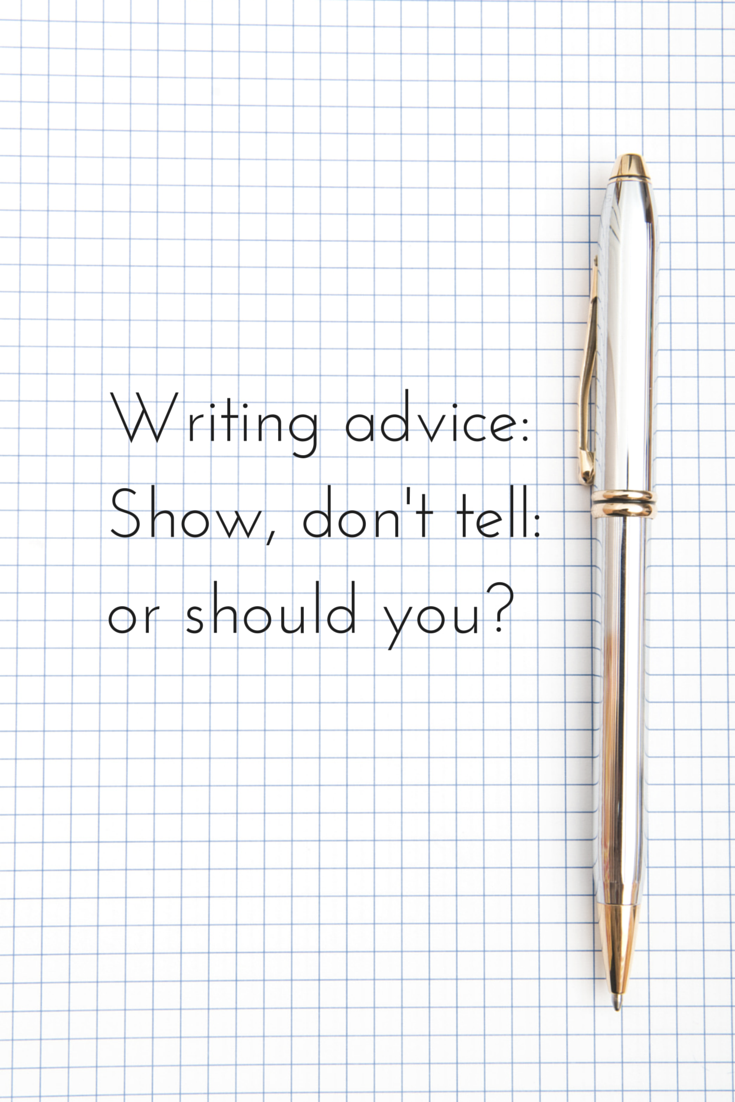“Show, don’t tell” is one of the most common pieces of advice given about writing, but should you follow this advice? In fact, sometimes you should tell (and not show). Here are some of the reasons why:
What does ‘Show, don’t tell’ mean?
First, let’s look at what the phrase means. ‘Show, don’t tell’ is often said to remind writers how much more powerful it is to put the reader in the thick of events rather than merely explain what is happening. Here’s an example:
- It was cold out. This is telling. The reader gets the information needed but it isn’t particularly evocative.
- The moonlight gleamed on the icy streets and the wind cut through Charlotte’s coat, numbing her hands. This is showing. Details that show the reader how cold it is rather than merely stating the fact non-descriptively.
Another reason why writing instructors are so enamoured of this advice is that beginning writers often have a habit of skipping over significant and climactic story points by quickly summarising what happened rather than putting the reader in the thick of things. “Show, don’t tell” helps to remind these writers that they need to make those moments visceral for the reader by showing them rather than simply telling the reader that they happened.
Despite the importance of showing the reader scenes which convey facts about characters and their environs, there are also times where the writer should sidestep the advice and tell. Showing instead of telling can have some disadvantages:
Showing everything may slow the narrative
If you’ve ever talked to a boring conversationalist, you’ll also appreciate why ‘show, don’t tell’ can be good writing advice. A dull conversationalist often gives the minimum information required, without enlivening it with details. If you ask someone unskilled at conversing if they enjoyed a particular talk, they might simply say yes. If you ask a more engaging conversationalist, they will probably describe what they liked about the talk and why they found it engaging.
However, you can start to understand how ‘show, don’t tell’ can be misplaced advice if you think about another type of dull conversationalist — the person who always has to go on and on and on when they tell a story rather than getting quickly to the point. Sometimses this can be interesting, but other times, you simply need to find out what happens without all the padding along the way.
The above can happen in fiction, too. If you need to get the protagonist from home to the office in the morning, the reader does not need all the details of how the character woke, what they ate and what their morning commute was like unless it is integral to the story. Most of the time, it’s sufficient to simply write something like ‘Barbara woke up early and was in the office before eight.’
Having been told ‘show, don’t tell’ too many times can bog down writers who need to become more efficient at conveying key backstory. For example, not every piece of information about a character’s past needs to come to her in a flashback. Too much showing and your back story could distract from the main story.
‘Show, don’t tell’ doesn’t necessarily ensure good writing
Another potential pitfall of ‘show, don’t tell’ is that showing and not telling is not always a sure path to good writing. In fact, the writing created by showing can be just as clichéd as the writing produced by telling. For example, rather than say that a character is worried, you might say the character is wringing her hands. Yet think about it: How often in real life have you ever seen someone wring their hands? Raising an eyebrow to indicate surprise caustically is another example of a clichéd gesture — not that many people can raise one eyebrow anyway. If someone’s heart hammers or stomach clenches because they are afraid, this is something the reader has read many times before. This is not an inherently better way of conveying fear.
On the other hand, telling can be very good writing sometimes. Saying showing is better than telling suggests that the narrative voice should be invisible in a novel, but this is not always the case. Sometimes, a novel may have a very distinctive narrative voice. Here are three examples:
- George was a fearful person who avoided public speaking, spiders, heights, flying, swimming, dark alleys, roller coasters, driving too fast, unfamiliar environments, large dogs, small dogs, lap dogs and ducks.
- George had known fear his entire life. Fear walked with him, dined with him and slept with him — fear of flying and falling, fear of speaking and not speaking, fear of connecting and of being forgotten, fear of the dark and fear of the light.
- I never knew anybody as scared of the world as George was. He was a coward right down to his bones, and everybody in town knew it about him.
In the first example, an arch, humorous effect is achieved through the repetitive sentence structure and the increasingly absurd list of objects of potential fear, while the second uses repetition to a more sober effect. Either of these narrative voices might be omniscient or third person limited. In the third example, the first-person narrative voice informs us of George’s fear. Consider that all of these are more effective and evocative in different ways than generic descriptions that “show” us that George is fearful instead of telling us.
Insisting on showing rather than telling at all times also ignored many of the major strengths of writing:
It’s may be too cinematic for your current purpose
Movies are for showing things to the audience. That’s their strength. In a pinch, they might resort to voice-over narration, but generally, we don’t get inside a character’s head, and we learn information through exposition and through watching the story unfold. Visual storytelling is one of film’s strengths, and it has access to a number of tools that fiction does not.
Now, imagine if movies suddenly decided that they needed to be more like fiction. They started going into the heads of various characters and telling us what they were thinking and relying on language to describe events that happened rather than showing us those events. We’d wonder what had happen to the visuals we expect. Even audiences who aren’t into special effects don’t attend a movie expecting to sit through the equivalent of an audio book.
In the same way, when we insist on showing all of the time and never telling, we are denying one of fiction’s essential powers, and that is the power of telling. The novel can enter characters’ heads and tell us what they are thinking and tell us why they are the way they are. We can say ‘She knew the bank would be crowded that morning’ without having to show the reader every detail of the implied space a character is dreading visiting.
It may be that the adage to show instead of telling rose from a rejection of the 19th century novel convention. This was perhaps the heyday of the novel form, but many conventions of the time have not survived into the 21st century. Novelists such as Charles Dickens and Anthony Trollope did not hesitate to tell their readers things. Often, the omniscient narrator of these novels would address the reader directly. The tone was often that of the narrator as another character who was relating the story to the reader.
The omniscient narrator is less popular than it once was, and a contemporary novel is more likely to use first person or third person limited. However, as demonstrated above, even these voices can make effective use of telling. Rejecting telling as a fiction technique essentially rejects an important aspect of storytelling.
Sometimes, the reader just needs help
Attempting to adhere to ‘show, don’t tell’ can leave a writer feeling as though they are playing a game of charades. How many clues are necessary to make a character’s tone of voice, intentions or emotions clear enough to the reader? Furthermore, a writer who relies too much on showing and not telling can run the risk of making private associations that pass readers by. Sometimes a simple declarative sentence is what the reader needs to get the point and move on.
However, doing so often involves breaking two other commonly heard writing rules. Writers are urged to avoid overuse of adjectives and adverbs as well forms of “be.” However, take a look at the sentences below that do quickly convey needed information and break all of these rules, and keep in mind that every sentence in a novel does not have to dazzle:
- Sarah looked sad. ‘I thought she would be there,’ she said defeatedly.
- Martin was exhuasted.
- She could tell he was angry again. ‘I found my clothes sitting in the washing machine again,’ he said.
In the first example, you could say that Sarah’s lip trembled or her eyes filled with tears, but how is that less of a cliché? In the second sentence, in some cases, you might want to be evocative in your description of Martin’s exhaustion, but you might just need to get this detail out of the way and move on. In the third example, the implication is that the speaker says seemingly innocuous things that someone who doesn’t know him as well as the point-of-view character might not see as angry. In this case, it is simply more efficient to tell the reader the viewpoint character’s impression.
‘Show, don’t tell’ is a common piece of writing advice, but it has its limitations. Telling can be an advantage in fiction as it can keep up the pace and allows for stylistic flourishes in narration. It also lets the writer play to fiction’s unique strengths over other narrative forms. Finally, it acknowledges that the reader does need to be given direct information sometimes.
What is one example of a time you found information needed to be conveyed by telling instead of showing?




6 replies on “Writing advice: Show, don’t tell: or should you?”
Great article – I couldn’t agree more! I especially found your comparison of the “dull vs. get to the point!” conversationalists to be SPOT ON. Because personally, I’ve found myself thinking “get to the point!” – much more often than I’ve found myself thinking “that was dull”. Which means as a reader – when it comes to the narration – I’ve definitely wanted MORE TELLING, and less showing!
You brought up movied as visual storytelling, meant to be shown, not told.. but often, they too are guilty of too much showing and not enough telling. I’m talking about something you mentioned, which is”exposition. Another perfect example of “not enough telling” is when filmmakers leave out unavoidable, and very much needed tool in film called “forced exposition”. Yes it comes across as cheesy and an ex-machina story-telling Method.. but it’s necessary at times to simply force in chunks of information and just TELL the audience. I can’t stand when Filmmakers insist audiences figure everything out from the visuals. It was a little too much, but I think of “X-Files” as a good example of how “forced exposition” , while yes, was pretty cheesy at times – was also, entirely necessary for audience comprehension
Thanks so much, Bryan. It’s all about being judicious – show the things that are interesting, funny, convey emotional affect or pivotal insights into your character. You make a good point regarding the X-Files. I think these different angles just go to show that rules should be placed second to not boring the reader.
The trouble is, I don’t like the result of “ show don’t tell”. My favourite reading matter is Victorian/ Edwardian and they told like mad- with very little showing. Because I prefer to read this style I also prefer to write it, so I’m going to just carry on as before and yes my omniscient voice often addresses the reader directly ?
Hi Rebecca, I love that! You do you. Of course if writing in a Victorian/Edwardian setting then Louisa May Alcott -style asides and sermons to the reader would fit the era. There’s always a caveat. Ursula K. Le Guin wrote a great piece here on the benefits of some telling, too.
Jordan–can’t get to the Ursula piece you recommend.
Pray tell!
Ha!
Hello Kadi, I can’t see anything relating to Ursula in this blog post?